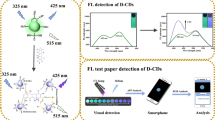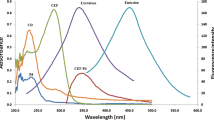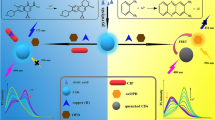Abstract
A novel ratiometric fluorescent probe for the determination of oxytetracycline (OTC) was developed. The method is based on the use of adenosine monophosphate/Eu(III) nanoscale coordination polymers doped with carbon dots (CDs) (CD@AMP/Eu NCPs). These were fabricated by self-assembly of Eu3+ and AMP on the surface of CDs containing large amounts of hydroxyl and carbonyl groups. Under the excitation at 310 nm wavelength, the doped NCPs display strong pink emission of Eu3+ at 615 nm and blue emission of the CDs at 430 nm on exposure to OTC. The ratio of fluorescence intensity (F615/F430) of such NCPs displays excellent linear relationship with OTC concentration ranging from 0.2 to 60 μM and the limit of detection (LOD) is 25 nM (3σ). The doped NCPs were evenly immobilized on common filter paper to prepare a visual ratiometric probe for the determination of OTC. Assisted by a digital camera with an APP color detector, the paper-based test strip was applied for the quantitative determination of OTC with a LOD of 0.5 μM and a wide linear scope of 1–100 μM. The method was applied to the determination of OTC in milk samples.

Schematic representation of the principle for oxytetracycline (OTC) determination using carbon dots (CD)@adenosine monophosphate (AMP)/Europium (Eu3+) paper-based ratiometic probe.







Similar content being viewed by others
References
Dai JD, Wei X, Cao ZJ, Zhou ZP, Yu P, Pan JM, Zou TB, Li CX, Yan Y (2014) Highly-controllable imprinted polymer nanoshell at the surface of magnetic halloysite nanotubes for selective recognition and rapid adsorption of tetracycline. RSC Adv 4(16):7967–7978
Chen GY, Liu GY, Qin F (2011) Use of a portable time-resolved fluorometer to determine oxytetracycline residue in four fruit crops. Food Chem 127(1):264–269
Kusano T, Kanda M, Kamata K, Miyazaki T (2004) Microbiological method for the determination of antibiotic residues in meat using mixed-mode, reverse-phase and cation-exchange cartridge. J Food Hyg Soc Jpn 45(4):191–196
Aga DS, Goldfish R, Kulshrestha P (2003) Application of ELISA in determining the fate of tetracyclines in land-applied livestock wastes. Analyst 128(6):658–662
Li YT, Qu LL, Li DW, Song QX, Fathi F, Long YT (2013) Rapid and sensitive in-situ determination of polar antibiotics in water using a disposable Ag-graphene sensor based on electrophoretic preconcentration and surface-enhanced Raman spectroscopy. Biosens Bioelectron 43:94–100
Zhu J, Snow DD, Cassada DA, Monson SJ, Spalding RF (2001) Analysis of oxytetracycline, tetracycline, and chlortetracycline in water using solid-phase extraction and liquid chromatography-tandem mass spectrometry. J Chromatogr A 928(2):177–186
Tan B, Zhao HM, Du L, Gan XR, Quan X (2016) A versatile fluorescent biosensor probe based on target-responsive graphene oxide hydrogel for antibiotic determination. Biosens Bioelectron 83:267–273
Ma XH, Du CC, Zhang JL, Shang MX, Song WB (2019) A system composed of vanadium(IV) disulfide quantum dots and molybdenum(IV) disulfide nanosheets for use in an aptamer-based fluorometric tetracycline assay. Microchim Acta 186:837
Tan HL, Ma CJ, Song YH, Xu FG, Chen SH, Wang L (2013) Determination of tetracycline in milk by using nucleotide/lanthanide coordination polymer-based ternary complex. Biosens Bioelectron 50:447–452
Esmaelpourfarkhani M, Abnous K, Taghdisi SM, Chamsaz M (2019) A fluorometric assay for oxytetracycline based on the use of its europium(III) complex and aptamer-modified silver nanoparticles. Microchim Acta 186(5):290
Qu F, Sun Z, Liu DY, Zhao XE, You JM (2016) Direct and indirect fluorescent determination of tetracyclines using dually emitting carbon dots. Microchim Acta 183(9):2547–2553
Yang XM, Luo YW, Zhu SS, Feng YJ, Zhuo Y, Dou Y (2014) One pot synthesis of high fluorescent carbon nanoparticles and their applications as probes for determination of tetracyclines. Biosens Bioelectron 56:6–11
Zhu A, Qu Q, Shao X, Kong B, Tian Y (2012) Carbon-dot-based dual-emission nanohybrid produces a ratiometric fluorescent probe for in vivo imaging of cellular copper ions. Chem Int Ed Engl 51(29):7185–7189
Singh N, Kaur N, Mulrooney RC, Callan JF (2008) A ratiometric fluorescent probe for magnesium employing excited state intramolecular proton transfer. Tetrahedron Lett 49(47):6690–6692
Freeman R, Willner I (2012) Optical molecular sensing with semiconductor quantum dots (QDs). Chem Soc Rev 41:4067–4085
Ma XF, Sun R, Cheng JH, Liu JY, Gou F, Xiang HF, Zhou XG (2016) Fluorescence aggregation-caused quenching versus aggregation induced emission: a visual teaching technology for undergraduate chemistry students. J Chem Educ 93:345–350
Li Q, Sun K, Chang K, Yu J, Chiu DT, Wu C, Qin WP (2013) Ratiometric luminescent determination of bacterial spores with terbium chelateds emiconducting polymer dots. Anal Chem 85(19):9087–9090
Lu LL, Feng CC, Xu J, Wang FY, Yu HJ, Xu ZA, Zhang W (2017) Hydrophobic-carbon-dot-based dual-emission micelle for ratiometric fluorescence biosensing and imaging of Cu2+ in liver cells. Biosens Bioelectron 92:101–108
Tan HL, Ma CJ, Chen LL, Xu FG, Chen SH, Wang L (2014) Nanoscaled lanthanide/nucleotide coordination polymer for detection of an anthrax biomarker. Sensors Actuators B Chem 190:621–626
Tan HL, Liu BX, Chen Y (2012) Luminescence nucleotide/Eu3+ coordination polymer based on the inclusion of tetracycline. J Phys Chem C 116:2292–2296
Guo XJ, Xu LP, Zhang LZ, Wang HY, Wang XM, Liu XH, Yao J, Hao AJ (2018) One-pot solid phase pyrolysis synthesis of highly fluorescent nitrogen-doped carbon dots and the interaction with human serum albumin. J Lumin 196:100–110
Iqbal A, Iqbal K, Xu L, Li B, Gong D, Liu X, Guo Y, Liu W, Qin W, Guo H (2018) Heterogeneous synthesis of nitrogen-doped carbon dots prepared via anhydrous citric acid and melamine for selective and sensitive turn on-off-on determination of Hg(II), glutathione and its cellular imaging. Sensors Actuators B: Chem 255:1130–1138
Hou J, Wang L, Zhang P, Xu Y, Ding L (2015) Facile synthesis of carbon dots in an immiscible system with excitation-independent emission and thermally activated delayed fluorescence. Chem Commun 51(100):17768–17771
Shen L, Chen M, Hu L, Chen X, Wang J (2013) Growth and stabilization of silver nanoparticles on carbon dots and sensing application. Langmuir 29(52):16135–16140
Nishiyabu R, Hashimoto N, Cho T, Watanabe K, Yasunaga T, Endo A, Kaneko K, Niidome T, Murata M, Adachi C (2009) Nanoparticles of adaptive supramolecular networks self-assembled from nucleotides and lanthanide ions. J Am Chem Soc 131(6):2151–2158
Qin ZX, Wang WH, Zhan XZ, Du XJ, Zhang QM, Zhang R, Li K, Li JH, Xu WP (2019) One-pot synthesis of dual carbon dots using only an N and S co-existed dopant for fluorescence determination of Ag+. Spectrochim Acta A Mol Biomol Spectrosc 208:162–171
Wang P, Li Y, Zhang C, Feng FQ, Zhang H (2020) Sequential electrospinning of multilayer ethylcellulose/gelatin/ethylcellulose nanofibrous film for sustained release of curcumin. Food Chem 308:125599
Miao H, Wang YY, Yang XM (2018) Carbon dots derived from tobacco for visually distinguishing and detecting three kinds of tetracyclines. Nanoscale 10(17):8139–8145
He JC, Li GK, Hu YL (2017) Aptamer-involved fluorescence amplification strategy facilitated by directional enzymatic hydrolysis for bioassays based on a metal-organic framework platform: highly selective and sensitive determination of thrombin and oxytetracycline. Microchim Acta 184:2365–2373
Acknowledgments
This work was supported by the National Natural Science Foundation of China (21465015), the program of Scientific Research Fund of Jiang Xi Provincial Education Department (grant no. 150366).
Author information
Authors and Affiliations
Corresponding author
Additional information
Publisher’s note
Springer Nature remains neutral with regard to jurisdictional claims in published maps and institutional affiliations.
Electronic supplementary material
ESM 1
(DOCX 794 kb)
Rights and permissions
About this article
Cite this article
Chen, L., Xu, H., Wang, L. et al. Portable ratiometric probe based on the use of europium(III) coordination polymers doped with carbon dots for visual fluorometric determination of oxytetracycline. Microchim Acta 187, 125 (2020). https://doi.org/10.1007/s00604-019-4104-3
Received:
Accepted:
Published:
DOI: https://doi.org/10.1007/s00604-019-4104-3




